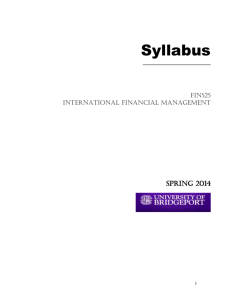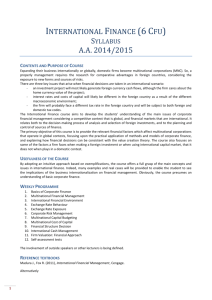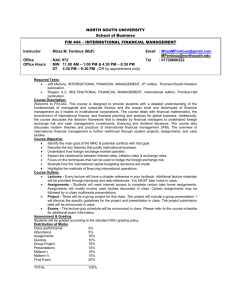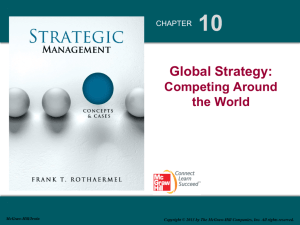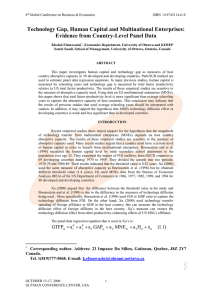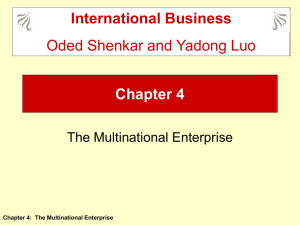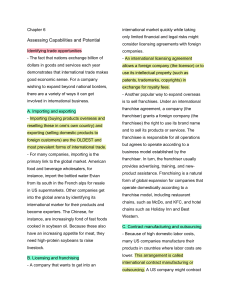Part 1 Global Financial Environment
advertisement
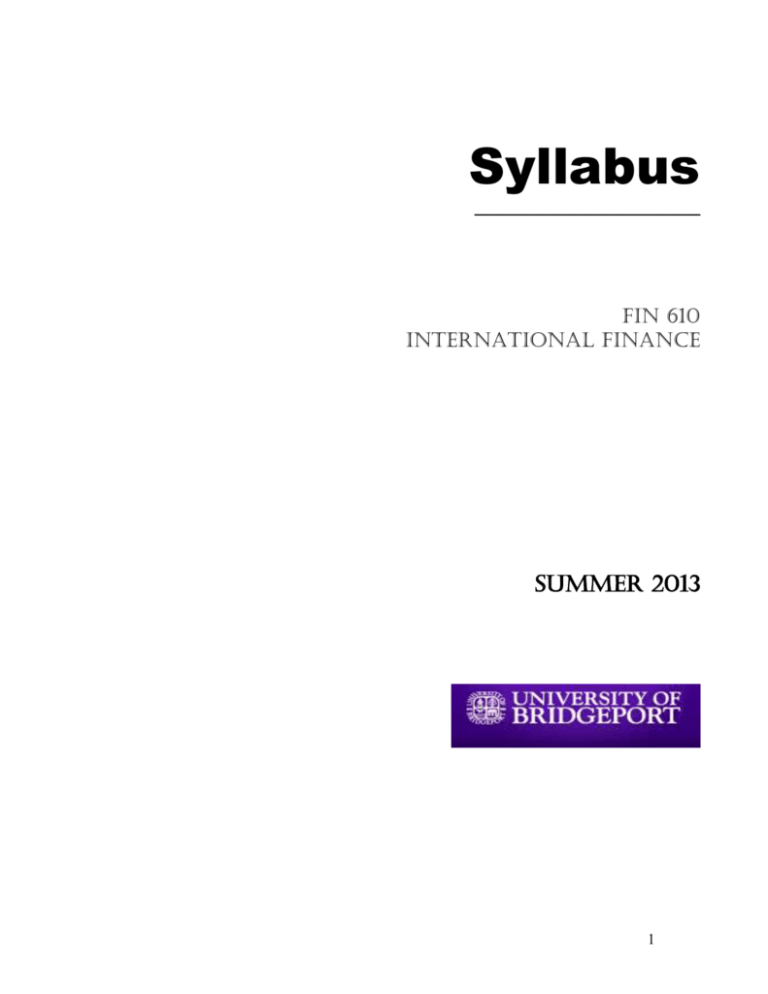
Syllabus ______________________________ FIN 610 International Finance Summer 2013 1 Course Syllabus Course Title FIN 610 International Finance School School of Business, University of Bridgeport Thursday: 12:45 PM -5:00 PM; May 16-July 18 (No class on July 4) Library 500C Course Schedule Course Location Instructor Office Telephone Congsheng Wu, Ph.D., Professor of Finance 203-576-4869 Email congwu@bridgeport.edu Office Location Mandeville Hall, Room 204 Office Hours Monday and Thursday: 5:00 PM - 6:00 PM Mailing Address 230 Park Avenue, University of Bridgeport, Bridgeport, CT 06604 Course Objective This is an introductory course about international financial management with special emphasis on multinational enterprises (MNEs). A MNE is defined broadly as one that is incorporated in one country, but has operating subsidiaries, branches or affiliates located in other countries. Today, almost all large companies are MNEs. Main topics to be covered in this course include the international monetary system, balance of payments, foreign exchange market, international parity conditions, exchange rate determination, currency derivatives, and foreign exchange risk management. Required Textbook and Readings Fundamentals of Multinational Finance, 4/E Moffett, Stonehill & Eiteman ©2012 | Prentice Hall | Published: 07/15/2011 ISBN-10: 0132138077 | ISBN-13: 9780132138079 Additional reading materials will be assigned in class. Class Procedure and Participation Class will consist of lectures and discussions of the assigned reading materials. Please show up on time. Students are expected to read the chapters assigned for each session beforehand and to participate in the discussions. Class participation accounts for 20% of the total grade. To receive 100% of the total grade points allocated to participation, you must meet the following expectation: during each class meeting, you need to engage in, and contribute to, classroom discussions in an active and positive manner, contributing to the learning objectives of the course. Business publications such as the Wall Street 2 Journal, The Economist and Financial Times provide excellent articles on various topics related to our class. Exams There will be two exams: the mid-term exam and the final exam. The mid-term exam will be given during regular class hours on June 13. There will be no make-up exam. Students who cannot take the exam must notify the instructor beforehand. The only acceptable excuses for missing the exam are incapacitating illness and other extreme emergencies. Students who miss the mid-term exam will only need to take the final exam, on July 18, and the final exam will account for 60% in the students’ final score of this course. Students are responsible for all materials presented in the lectures. Homework Assignments Homework will be assigned regularly and account for 20% of the total grade. All assignments must be submitted with a hardcopy at the start of the class. Unless stated otherwise, all written assignments are to be typed, double spaced, proofread and corrected for grammatical, spelling and typographical errors. Late homework will not be accepted. Academic Honesty Academic honesty is highly valued. Plagiarism, copying each other’s homework and cheating during exams are absolutely not allowed. A student must always submit work that represents his or her original words or ideas. If words or ideas that do not represent the student's original work are used, the student must cite all relevant sources as references. The student should also make clear the extent to which such sources were used. Words or ideas that require citations include, but are not limited to, all hardcopy or electronic publications, whether copyrighted or not, and all verbal or visual communication when the content of such communication clearly originates from an identifiable source. It is the student's responsibility to familiarize himself or herself with and adhere to the standards set forth in the policies on cheating and plagiarism as defined in Chapters 2 and 5 of the Key to UB at www.bridgeport.edu/pages/2623.asp or in the appropriate graduate program handbook. Electronic Devices Please turn off your electronic devices except perhaps your laptop computers. However, please don’t use your laptop to check emails, watch video, or go to unrelated web sites. 3 Grading Please note that everyone starts with an A. How you maintain that grade is up to you. Following is my ideal student: A = The student who: Is an excellent performer Has unusually sharp insight into materials and initiates thoughtful questions Sees many sides of an issue Articulates well and writes logically and clearly Integrates ideas previously learned from this and other disciplines Anticipates next steps in the progression of ideas Submits assignments on time Is in full attendance Constructively contributes to the learning environment Your final grade will be determined as below: Class participation Homework assignments Midterm exam Final exam 20% 20% 30% 30% Main Topics and Chapter Assignments Part 1 Global Financial Environment This course is about the international financial management with special emphasis on the multinational enterprises (MNEs). A MNE is defined broadly as a firm that is incorporated in one nation, but has operating subsidiaries, branches or affiliates located in foreign countries. Part 1 introduces the global financial environment in which MNEs operate. Chapter 1 provides an introduction to the globalization process and the global economy. Chapter 2 focuses on one of the major challenges facing MNEs, their financial goals and how these goals can be achieved. Chapter 3 discusses the history of the international monetary system as well as the contemporary currency arrangements around the world. Chapter 4 explains how to summarize all cross-border financial transactions between one nation and the rest of the world. And this summary is referred to as the balance of payments (BOP). MNEs use various BOP measures to gauge the growth and health of specific types of foreign trade and financial transactions against the host country. Chapter 5 provides a detailed coverage of the credit crisis of 2007-2009. Chapter 1 Chapter 2 Chapter 3 Current Multinational Challenges and the Global Economy Financial Goals and Corporate Governance The International Monetary System 4 Chapter 4 Chapter 5 The Balance of Payments Current Multinational Financial Challenges: The Credit Crisis of 2007-2009 Part 2 Foreign Exchange Theory and Markets Part 2 describes how the currency market works and examines the behavior of the foreign exchange rates as the background knowledge that must be understood by management of MNEs in order to measure and manage their firms’ foreign exchange risks. Chapter 6 describes how the foreign exchange market operates. Chapter 7 establishes the link between foreign exchange forward rates and interest rates, the purchasing power parity and the international Fisher effect. Chapter 8 discusses currency derivatives, which include currency futures, options and swaps. Chapter 6 Chapter 7 Chapter 8 The Foreign Exchange Market International Parity Conditions Foreign Currency Derivatives and Swaps Part 3 Foreign Exchange Exposure This part examines how changes in exchange rates affect the multinational enterprise’s profitability, cash flow, and market value. Two types of foreign exchange exposure are identified and examined: transaction exposure and operating exposure. Chapter 9 investigates what determine and how to forecast foreign exchange rates. Chapter 10 discusses the basic techniques to manage transaction exposure. Chapter 9 Chapter 10 Foreign Exchange Rate Determination & Forecasting Transaction and Translation Exposure Welcome to My Class 5


